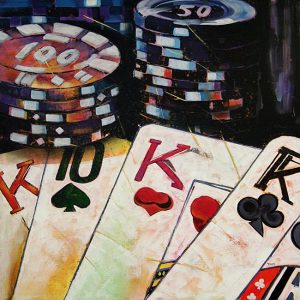
In order to further analyze the behavioral patterns of opponents, we need to discuss the important concept of leveling.
There is probably no other word in the poker lexicon that is so misunderstood and misused. Players use this term to justify every terrible play and explain all complex phenomena. In poker language, it has become synonymous with “outsmarting someone.” This word has become so vague that to understand it, we need to clearly define the term itself.
The concept of leveling is misunderstood due to the connotation of the word. When we talk about “levels,” especially when we say that someone is on a higher “level,” we metaphorically arrange everything vertically. Therefore, if we talk about someone on a lower level, we see them on the ground, someone on a higher level somewhere in the sky, and if even higher, above the clouds, and so on. We arrange it similarly to the layers of the atmosphere. We imagine good poker players playing at such a fantastically high “level” that it would be impossible for us to even comprehend what just happened between them up there.
But what is this “level” really? Let's be precise here. When we choose a certain level, what we are actually choosing is one action or strategy. When our opponent tries to counter our strategy, the level “above that” is what counters his counter-strategy. And above that?
In fact, there is nothing above that.
Let's examine an example. Let's say a very drawy board finally ends with these cards: 4♥9♥7♣2♣2♦. There were many different draws, but they all missed now. Now it's the opponent's turn, he bet on every street. He also showed us that he is inclined to take risks and is attached to money. In this case, our first “level” would be to catch his bluff because we expect him to bet again. If the opponent guessed our conclusions, he might not bluff at all. But if we anticipate this by consistently calling and not catching any bluffs, we reach the second “level.” Now let's say he has very strong insight and expects us to make a high-level counter, so he returns to his original strategy to withstand this change. This is his third “level.” Our third level would be to return to bluff catching. I emphasize, the first and third levels are identical strategies. So where is the difference?
The difference arises from the ability to adapt. Players who play at the first level rarely deviate from their level. The first level is also characterized by the fact that it is the game played by most poor players and requires little awareness. The second level is defined as a counter-strategy to the first level game, it is like a correction to the first level. Using the second level does not necessarily mean flexibility in changing levels. A second-level player can remain playing at the second level, constantly exploiting first-level players.
So, when we say that the game has reached the third level, what we really mean is that it is a consciously chosen first level, where someone chooses to play at the first level with flexibility and awareness that they can maneuver between different “levels” depending on the  course of the game. And above that?
course of the game. And above that?
There is no need to talk about a “level” above the third level. It is a silly idea, but it reveals the fact that most people do not understand how the adjustable game works. As you can see, theoretically, there are only two levels, but we arbitrarily decide to define the first level as the level for people who cannot participate in the leveling game. Saying that someone is playing a fifth-level game is meaningless. The third “level” is simply a repetition of the first level strategy, the fourth “level” would be a repetition of the second level, the fifth level, again a repetition of the first strategy, and so on.
The third level is actually a free-flow game where adjustments occur between the first and second “levels.” A first-level player almost never or very rarely adjusts their game, a second “level” player can also get stuck in it, exploiting the first level. A third-type player is flexible, aware, and skillfully chooses situations where they maneuver between the appropriate levels. In high-level play, you can see the interaction between the first and second “levels.”
The most important thing to know is that the leveling game ends. It does not rise into the air higher and higher. It is limited and conquerable. The game of high-level players is not something special that you cannot play “at their level.” Once you reach a conscious degree of flexibility, the same arena will open up to you as it does to them.
Essentially, leveling is a guessing game, similar to rock-paper-scissors. A player guesses which level their opponent will choose and makes corresponding adjustments to their strategy. Very similarly to the game flow. If we define game flow as the skill to read and guess the opponent's premeditated game patterns, then analogously, the leveling skill is the ability to predict which counter-strategy model the opponent will choose.





